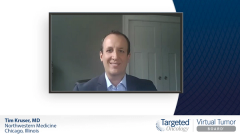
Case 3: Chemoradiation for Stage III NSCLC
Episodes in this series

Tim Kruser, MD: Here’s the schema for RTOG 9410. It is an old study, so I won’t spend too much time on this. It compared sequential chemoradiotherapy with 2 forms of concurrent radiotherapy—1 with twice-daily radiation, which we don’t really use and was not significantly different—and the outcomes for the concurrent chemotherapy with once-daily radiation was significantly better. If you look at the study results, here are the overall survival results. At 5 years, the overall survival is 16% for concurrent chemoradiotherapy vs 10% for sequential. This really set the stage for subsequent examinations. Sadly, this was again launched in 1994, and we really didn’t have any breakthroughs until PACIFIC, which we’ll touch upon in a few slides. Here’s RTOG 0617. I kind of previewed this. This was a dose-finding study, standard dose being 60 Gy vs an experimental dose of 74 Gy. It was a randomized study, 460 patients, and overall survival was the primary outcome. As radiation oncologists, we all like to think that more dose is better, and we were a little disheartened to see these results. To many, it was a surprise that the 60-Gy arm is numerically and statistically significantly better than the 74-Gy arm for overall survival. This is the progression-free survival curves. They’re relatively close, but when you flash ahead and look at the overall survival curves, there’s actually more distance between those curves and more significance, suggesting that the excessive dose with 74 Gy is driving some noncancer deaths. These were not all because of progressive events from cancer but seemed to be toxicity related.
Looking at the adverse effects, here’s the 60-Gy arm vs the 74-Gy arm. Numerically, these were not different. That P value is actually a little misleading. This was a 4-arm study, which included 2 cetuximab arms. We haven’t discussed those because that therapy was not beneficial. But looking at the standard dose vs the high dose, the adverse effects were not statistically significantly different.
That said, if we look at the treatment-related deaths, there was a concerning number of treatment-related deaths and also noncancer deaths that were maybe not attributed to radiation in the 74-Gy arm. If we look at the ones that were probably or likely attributed to radiation, we see events for radiation pneumonitis, respiratory failure, tracheo-esophageal fistulas. Numerically, these were all more common in the 74-Gy arm. Here are the patterns of failure data for RTOG 0617. It describes how the high dose did not achieve better disease-related outcomes in terms of local or regional control in the 60-Gy arm. I think that was disheartening to many people who ran the study.
Looking at factors related to survival, the high dose on multivariate analysis comes out to be a negative prognostic factor. Additionally, heart dose was a negative predictor, speaking to high dose being associated with noncancer deaths. Likewise, tumor location, the left lower lobe, again probably related to heart dose, was a problematic prognostic factor.
If we summarize RTOG 0617, the standard-dose arm of 60 Gy remains the standard of care, despite efforts to intensify a dose selection or dose escalation in these patients. The median survival was 28 months. The 5-year overall survival was 32% here vs 16% that we highlighted back in the 1994 study. Undoubtedly some were from stage migration but there was also improvement of radiation technology with IMRT utilization and better systemic therapy.
Mark Socinski, MD: Tim, thanks for that. I wanted to ask you a couple of questions, because a lot of people were surprised with RTOG 0617. I spent the first part of my career at the University of North Carolina doing dose-escalation trials for 74 Gy into what used to be the CALGB [Cancer and Leukemia Group B trial] there, and obviously we were thinking this would be the winner. I have 2 questions. Why do you think this happened, that 74 Gy was worse? You were alluding a little to normal tissue toxicity, particularly the heart. But also the recurrence patterns here. I just wonder if many radiation oncologists were very conservative in their fields and might have had marginal misses because they had to go to 74 Gy and they didn’t want to over radiate the lung or this or that or everything else. That’s 1 question. The second question is that every radiation oncologist I talk to doesn’t think 60 Gy is a great dose, and they actually go to 66, 70 Gy in select patients. Even though these data as presented are pretty convincing, the nuances of the data are what we all continue to ruminate about and try to figure out how can we explain this. It shouldn’t make sense. I just want to get your perspective on that.
Tim Kruser, MD: Those are definitely some great questions. We radiation oncologists all need to be judicious with our radiation. We know from earlier studies, where we gave radiation for post-op RT, for early stage disease, that thoracic radiation—when it’s not adequately addressing disease—is morbid and contributes to mortality. We’re seeing a single of that in the RTOG 0617 data. I do believe it. As to why the disease-related outcomes or local control were not different, there were some data suggesting there were some less-than-rigorous radiation quality in the higher-dose arm, perhaps related to what you alluded to in terms of people scaling back on margins, for example. Did that contribute to marginal misses? It’s hard to know, but potentially.
What dose do I use now, and do I think 60 Gy is the right dose? We are talking about using this with dual-agent concurrent chemotherapy, and that needs to be highlighted. Sixty Gy may be enough, especially in the setting of the PACIFIC data, which we’re going to talk about. I’m rarely going above 60 Gy because I really want to make sure these patients are not harmed by my therapy, because we know we have something that comes after that has an overall survival benefit. I’m very cautious about going beyond 60 Gy. I do it occasionally for the low-volume patient for whom the disease is relatively close in proximity between the nodal disease and the primary disease, and lung and heart parameters are easily met. But we have to take our medicine with these data and believe that more is not always better.
Mark Socinski, MD: That’s an excellent perspective. Ed, chemotherapy regimens? That might be 1 of the least interesting things to talk about in terms of what we use with radiotherapy. I think our national platforms are either carboplatin-Taxol or cisplatin-etoposide, and there are a lot of chemotherapy drugs you can use with radiation. I took to heart the PROCLAIM trial. We all thought pemetrexed would be a great radiation drug with cisplatin, and it turned out to be no different from cisplatin-etoposide. Your thoughts?
Edward Kim, MD: I’ve always been a cisplatin fan because in the curative setting, it seems to lean a bit that way. Of course, when I was at MD Anderson, they liked to talk about how radiation is the best in the world at MD Anderson. It’s better than anywhere else in the country. That would negate the cisplatin effect, and you could use carboplatin. I’m kidding, but it was kind of true. As someone who also treated head and neck, we’re not scared of giving high-dose cisplatin. We can give 100 per m2. So I don’t understand when people get really skittish when we’re giving lower doses in lung. I tend to be a cisplatin-etoposide person. We have carboplatin-Taxol weekly on our regimens. I don’t know if it’s necessarily easier to take, but it’s what people are comfortable giving.
Transcript edited for clarity.









































